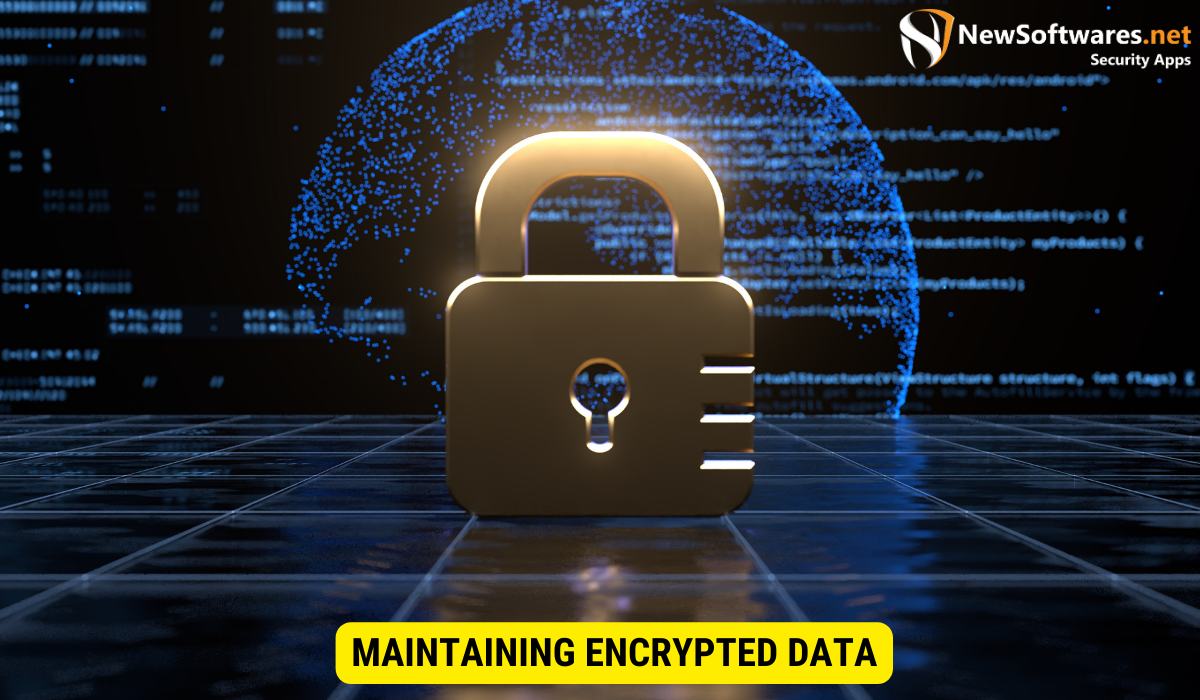Data encryption is a vital process that transforms plain text data into ciphertext, ensuring its confidentiality and integrity. Common data encryption exceptions, for instance unauthorized access or key management issues, can be resolved by identifying the exception, investigating the root cause, creating a resolution plan, implementing it, and monitoring the outcome. Factors like data sensitivity, regulatory requirements, and key management capabilities should be considered before implementing encryption, and ongoing security measures, including regular checks and strong key management, are crucial to maintaining the security of encrypted data in today’s digital landscape.
Data encryption is an essential aspect of protecting sensitive information from unauthorized access. However, there may be instances where data encryption exceptions occur, throwing a wrench in the security measures. Together, we will delve into the intricacies of data encryption, explore common exceptions that may arise, and discuss effective ways to resolve them.
Understanding Data Encryption

Data encryption transforms plain text data into ciphertext using cryptographic algorithms, making it unintelligible to anyone without the corresponding decryption key. It is a vital safeguard against data breaches and illegal access, ensuring the confidentiality and integrity of sensitive information.
Data encryption is crucial in today’s digital landscape, where cyber threats are becoming increasingly sophisticated. With the increase in data breaches and unauthorized access attempts, organizations must prioritize the implementation of robust encryption methods to protect their valuable data assets.
The Importance of Data Encryption
The significance of data encryption cannot be understated, especially in a world where digital threats are prevalent. organizations can mitigate the risk linked with data breaches, unauthorized access, and information leakage by encrypting data. Encryption provides additional protection to sensitive data, ensuring its confidentiality even if it falls into the wrong hands.
Imagine a hacker gaining unauthorized access to a company’s database. Without encryption, the hacker would immediately access all the sensitive information stored within, such as customer data, financial records, and trade secrets. However, with robust encryption, the stolen data would be rendered useless to the hacker, as it would appear as a jumble of meaningless characters without the decryption key.
Furthermore, data encryption is not limited to protecting data at rest. It also plays a key role in securing data in transit. When sensitive information is transmitted over networks, encryption ensures that it remains confidential and cannot be intercepted or tampered with by malicious actors.
Basic Principles of Data Encryption
Data encryption follows a set of fundamental principles to ensure its effectiveness. These principles include confidentiality, integrity, availability, and non-repudiation. Confidentiality restricts access to authorized individuals, while integrity ensures the data remains unaltered. Availability guarantees that data is accessible when needed, while non-repudiation prevents individuals from denying their actions or data validity.
Confidentiality is achieved through encryption algorithms that scramble the original data into ciphertext. Only persons with the appropriate decryption key can decipher the ciphertext and retrieve the original information. This principle ensures that sensitive data remains confidential and inaccessible to unauthorized parties.
Integrity is maintained by employing cryptographic hash functions that generate unique values for each piece of data. These hash values act as digital fingerprints, allowing the recipient to verify the reliability of the data. If any modifications or tampering occur during transmission or storage, the hash value will change, indicating a potential breach of integrity.
Availability is a critical principle in data encryption, as it ensures that authorized individuals can access the encrypted data when needed. Encryption methods should be designed to minimize any performance impact on data access and retrieval, allowing for seamless and efficient operations.
Lastly, non-repudiation ensures that individuals cannot deny the validity of their actions or data. Through digital signatures and certificates, encryption can provide evidence of the origin and integrity of data, making it difficult for individuals to dispute their involvement in a transaction or communication.
Common Data Encryption Exceptions
While data encryption provides a robust security measure, there are instances where exceptions may occur. Understanding and identifying these exceptions is crucial for maintaining a secure environment for sensitive data.
Identifying Data Encryption Exceptions
Identifying data encryption exceptions is imperative to address and resolve them effectively. Data encryption exceptions can manifest in various forms, such as unauthorized access, system compatibility issues, key management mishaps, and human error. Organizations can promptly recognize any possible exceptions by proactively monitoring and analyzing data encryption processes.
Causes of Data Encryption Exceptions
Data encryption exceptions can occur due to a multitude of reasons. Inadequate encryption implementation, software or hardware issues, misconfiguration of encryption settings, and outdated encryption protocols can all contribute to exceptions. Human error, lack of employee training, and insufficient key management practices can also lead to encryption exceptions. Identifying the root causes is crucial for effective resolution and preventing future exceptions.
Resolving Data Encryption Exceptions
Resolving data encryption exceptions requires a well-structured approach and the use of appropriate tools and techniques. By following steps and implementing best practices, organizations can navigate these exceptions and ensure that their data remains secure.
Steps to Resolve Data Encryption Exceptions
When faced with data encryption exceptions, the following steps can be followed:
- Identify the exception: Analyze and understand the nature of the exception to determine its underlying cause.
- Investigate the root cause: Dig deeper to identify the specific reason or vulnerability that led to the exception.
- Develop a resolution plan: Based on the root cause analysis, create a comprehensive plan for resolving the exception.
- Implement the resolution: Execute the plan, address the root cause, and implement any necessary changes or updates.
- Monitor and test: Continuously monitor the data encryption processes, conduct regular tests, and verify that the exception has been resolved effectively.
Tools for Resolving Data Encryption Exceptions
There are various tools and technologies available that can aid in resolving data encryption exceptions. These include encryption key management systems, intrusion detection systems, data loss prevention solutions, and vulnerability scanning tools. Leveraging these tools can streamline the resolution process and improve the overall security posture of an organization.
Can You Encrypt the Data?
Before implementing data encryption, it is important to consider a few factors to determine if it is the right solution for your needs.
Factors to Consider Before Encrypting Data
– Sensitivity of the data: Assess the level of sensitivity and confidentiality of the data that requires encryption.- Applicability of regulatory requirements: Determine if relevant industry regulations or compliance frameworks mandate encryption.- Performance implications: Evaluate the potential impact of encryption on system performance and user experience.- Key management capabilities: Consider the organization’s ability to securely manage encryption keys throughout their lifecycle.- Cost considerations: Analyze the financial implications associated with implementing and maintaining data encryption solutions.
Pros and Cons of Data Encryption
Pros of data encryption include enhanced data security, compliance with industry regulations, and protection against data breaches. However, there are also potential drawbacks, such as potential performance degradation, added complexity in managing encryption keys, and potential compatibility issues with legacy systems. A detailed analysis of these pros and cons is essential to determine if data encryption aligns with your requirements and constraints.
Maintaining Encrypted Data

Once data is encrypted, it is crucial to establish a robust framework for maintaining the security and integrity of the encrypted information.
Regular Checks and Balances for Encrypted Data
Monitoring and reviewing encrypted data is essential to detect and address potential vulnerabilities or exceptions. Conducting periodic audits, penetration tests, and vulnerability assessments can help spot any weaknesses and ensure the ongoing integrity of the encrypted data.
Ensuring the Security of Encrypted Data
In addition to regular checks and balances, organizations must implement comprehensive security measures to ensure the continued protection of encrypted data. This includes robust access controls, secure key management practice, regular software updates, and employee training on encryption best practices. By maintaining a vigilant stance on the security of encrypted data, organizations can minimize the likelihood of exceptions and maximize the effectiveness of their encryption efforts.
Key Takeaways
- Data encryption is crucial for safeguarding sensitive information from unauthorized access.
- Data encryption exceptions can occur for various reasons, including system compatibility issues and human error.
- Identifying and resolving data encryption exceptions requires a systematic approach and the utilization of appropriate tools.
- Before implementing data encryption, organizations must consider factors such as data sensitivity and regulatory requirements.
- Maintaining the security of encrypted data involves conducting regular checks, implementing robust security measures, and ensuring secure key management practices.
FAQs
What is data encryption?
Data encryption is transforming plain text data into ciphertext using cryptographic algorithms to ensure its confidentiality and integrity.
What are some common data encryption exceptions?
Data encryption exceptions include unauthorized access, system compatibility issues, key management mishaps, and human error.
How can data encryption exceptions be resolved?
Data encryption exceptions can be resolved by following a systematic approach, including identifying the exception, investigating the root cause, developing a resolution plan, implementing the resolution, and monitoring the outcome.
What factors should be considered before encrypting data?
Data sensitivity, regulatory requirements, performance implications, key management capabilities, and cost considerations should be evaluated before implementing data encryption.
What measures can be taken to ensure the security of encrypted data?
Ensuring the security of encrypted data involves regular checks and balances, robust security measures, secure key management practices, software updates, and employee training.
Conclusion
Data encryption is critical to maintaining the security and integrity of sensitive information. However, data encryption exceptions do arise, posing challenges to organizations. By understanding data encryption principles, identifying common exceptions, and implementing effective resolution strategies, organizations can navigate these exceptions and ensure the ongoing security of their data. By considering factors before encrypting data and implementing proper maintenance practices, organizations can harness the power of encryption while minimizing risks. Embracing data encryption as a comprehensive security measure is essential in today’s digital landscape.
